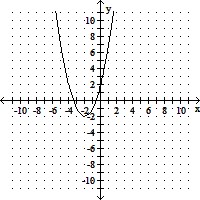Use a graphing utility to graph the function over the indicated interval and approximate any local maxima and local minima. Determine where the function is increasing and where it is decreasing. If necessary, round answers to two decimal places.f(x) = x3 - 3x + 3, (-2, 2)
A. local maximum at (1, 1)
local minimum at (-1, 5)
increasing on (-2, -1) and (1, 2)
decreasing on (-1, 1)
B. local maximum at (-1, 5)
local minimum at (1, 1)
increasing on (-1, 1)
decreasing on (-2, -1) and (1, 2)
C. local maximum at (1, 1)
local minimum at (-1, 5)
increasing on (-2, -1)
decreasing on (-1, 1)
D. local maximum at (-1, 5)
local minimum at (1, 1)
increasing on (-2, -1) and (1, 2)
decreasing on (-1, 1)
Answer: D
You might also like to view...
Describe how to transform the graph of f into the graph of g.f(x) =  and g(x) = 6
and g(x) = 6
A. Vertical scaling by a factor of 6
B. Horizontal scaling by a factor of 6
C. Vertically scaling by a factor o 
D. Horizontal scaling by a factor of 
The point P(x, y) on the unit circle that corresponds to a real number t is given. Find the values of the indicated trigonometric function at t. ?Find sec t.
?Find sec t.
A. 
B. 
C. 
D. 
Solve. x > 27
x > 27
A. x < 
B. x < 30
C. x > 30
D. x > 
The graph of a quadratic function is given. Choose the function's equation.
A. f(x) = (x - 2)2 + 2 B. f(x) = (x - 2)2 - 2 C. f(x) = (x + 2)2 - 2 D. f(x) = (x + 2)2 + 2